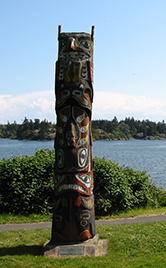 For thousands of years, First Nations people lived on the Gorge Waterway and used the area for food-gathering and spiritual purposes. Shellfish, seaweed, herring and salmon were harvested from the sea, birds and wildlife such as deer, elk and bear were hunted, and plants for food and medicine were gathered from the surrounding forests.
For thousands of years, First Nations people lived on the Gorge Waterway and used the area for food-gathering and spiritual purposes. Shellfish, seaweed, herring and salmon were harvested from the sea, birds and wildlife such as deer, elk and bear were hunted, and plants for food and medicine were gathered from the surrounding forests.
After the establishment of Fort Victoria in 1843, the Gorge Waterway soon became a recreation destination for local residents, with numerous boating regattas, canoe races, swimming and diving competitions and sightseeing trips to the famous reversing tidal falls at the Gorge Narrows.
During the same period, the Gorge and Victoria Harbour areas became the site of many industries, including sawmills, ship building, paint manufacturing and fish processing. The residential areas surrounding the Gorge all discharged their sewage directly into the water until about 1955.These activities took their toll on the water quality of the Gorge, and by the late 1930s it was no longer considered safe for swimming.
In the 1990s, a local father and son started cleaning up junk in the much-abused Gorge Waterway. This action, along with some publicity, inspired local businesses, non-profit organizations and governments to pitch in. Clean-up efforts are now conducted regularly by local groups, and the importance of environmental stewardship of the Gorge is widely recognized by the community. An effective regional source control program now restricts the type of waste that is permitted to enter the city’s sewers and storm drains, helping water quality in the Gorge and other harbours to improve.
In 2012 the first annual Gorge Swim Fest was held, attracting hundreds of people. This has re-kindled interest in swimming in the Gorge and has led to further water quality improvements. Once again, recreational boating has become very popular once along the Gorge. Kayaks, canoes, rowing sculls, dragon boats and paddle boards are common sights up and down the waterway. International boating festivals and several regattas are regularly held on the Gorge. A fleet of small harbour ferries carry commuters and tourists to several public ferry docks along the waterway as far as the Gorge Narrows.
Many of the former industrial sites in the Selkirk Water area in the lower Gorge have been replaced with residential housing. The Selkirk train trestle has been converted to a pedestrian and cycle bridge that forms part of the popular Galloping Goose multi-use trail. Ship repair and other industries in Victoria Harbour may still affect the water quality of the Gorge, but the main pollution concerns now are from non-point sources such as run-off from the large proportion of impervious surfaces (roofs, roads, parking lots, etc) in the watersheds that drain to the waterway.
More information on Gorge history:
- Dennis Minaker, 1998. The Gorge of Summers Gone, A History of Victoria’s Inland Waterway.